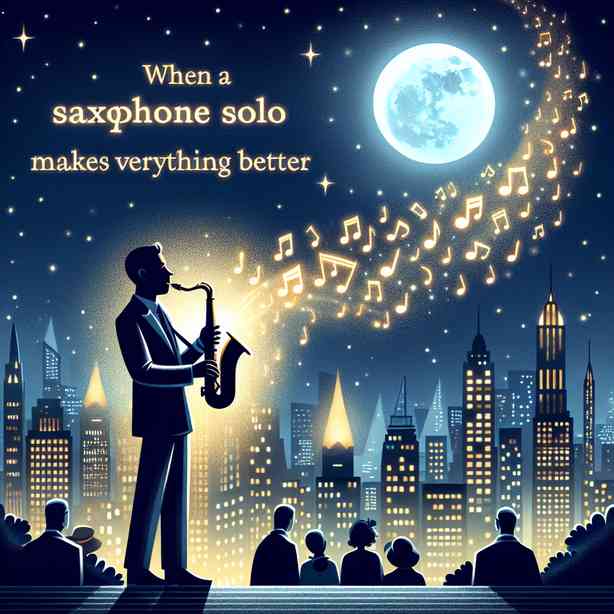
Saxophone solos have a unique ability to transform any musical piece into something extraordinary. The saxophone, with its rich tone and expressive capabilities, allows musicians to convey emotions that resonate deeply with listeners. Whether it’s in a jazz ensemble, a pop arrangement, or a classical setting, the impact of a saxophone solo can elevate the entire composition. This article will explore the reasons why a saxophone solo can enhance the listening experience, delving into the instrument’s history, its role across different genres, and the emotional connection it fosters.
The saxophone was invented in the early 1840s by Adolphe Sax, a Belgian instrument maker. His intention was to create an instrument that blended the qualities of brass and woodwind instruments, achieving a sound that is both powerful and warm. The saxophone quickly gained popularity among military bands and orchestras, and over the decades, it found its niche in various musical genres, especially jazz. In jazz, the saxophone serves as a primary voice, allowing for improvisation that can range from soothing melodies to intense, rapid-fire runs.
One of the most compelling aspects of a saxophone solo is its flexibility. Saxophonists can manipulate tone, pitch, and rhythm, crafting solos that can either linger in the air like a nostalgic memory or burst forth with vibrant energy. This versatility makes the saxophone particularly effective in emotional storytelling through music. A solo can captivate an audience, drawing them in with heartfelt phrases or exhilarating climaxes. The listener is often taken on a journey—each note a step, each phrase a new chapter—leading to a profound connection with the music.
In jazz settings, saxophone solos often showcase the musician’s technical prowess and personal style. Iconic jazz saxophonists like John Coltrane, Charlie Parker, and Sonny Rollins have set standards for improvisation and expression that many aspire to. Their solos are not just musical interludes; they are masterclasses in emotional depth and technical skill. Each time they play, they channel personal experiences and feelings, creating a sense of authenticity that resonates with audiences. This connection not only enhances the specific performance but also contributes to the legacy of jazz music as a whole.
The emotional weight of a saxophone solo can be particularly substantial in contemporary music, where the saxophone often serves as a standout feature in pop and R&B tracks. Artists like Kenny G, Lisa Simpson from “The Simpsons,” and more recently, players like Kamasi Washington, have showcased the saxophone’s ability to bridge genres and appeal to diverse audiences. A well-placed saxophone solo in a pop song can take the listener by surprise, adding layers of complexity and emotion that may not have been present in the verses or choruses. These moments can create unforgettable highlights in a song, making the entire composition feel more vibrant and alive.
Furthermore, the saxophone is often recognized for its soulful quality, which can evoke feelings of nostalgia and longing. When a saxophonist plays a solo, it can remind listeners of memories, dreams, and even heartbreak. This emotional resonance is one reason saxophone solos are frequently used in films and television. A poignant moment accompanied by a sax solo can amplify the drama, pulling viewers into the story’s emotional landscape. It is not just about the notes being played; it is about how those notes make the audience feel.
The saxophone’s ability to convey sadness, exuberance, passion, or tranquility makes it an incredibly valuable tool for musicians. During decisive moments in a performance—whether it be a dramatic love scene in a movie or a climactic end to a concert—a saxophone solo can linger in the mind long after the music has stopped. The sound and style of a sax solo can become emblematic of a particular era or movement in music, influencing upcoming artists and shaping public taste.
Moreover, the technical aspects of playing the saxophone contribute to the depth of a solo. Through the use of techniques such as bending notes, growling, and varying breath control, saxophonists can express a wide array of emotions. This level of control allows for nuanced interpretations of a melody—something that can elevate a song from merely pleasant to profoundly moving. Audiences may experience the thrill of a high-energy solo filled with runs and arpeggios, or they may find themselves wrapped in the warmth of a slow, soulful melody.
Live performances often showcase saxophone solos in their purest form. The energy of the crowd can push a musician to new heights, leading to spontaneous and electrifying moments that define a concert. In these instances, the connection between the performer and audience reaches a level where every note is infused with shared excitement and emotion. The improvisational nature of jazz and the interplay between musicians allow for unique interpretations of the same piece, ensuring that no two performances are alike. This unpredictability keeps the music vibrant and engaging, drawing listeners deeper into the experience.
The impact of a saxophone solo extends beyond individual performances; it can shape music culture and inspire entire generations of musicians. Young saxophonists look up to their predecessors, learning from their styles and interpreting them through their unique lenses. As new artists continue to push the boundaries of saxophone playing, the instrument remains relevant and influential in contemporary music scenes.
In conclusion, saxophone solos undeniably elevate music, transforming it into an emotional journey for the listener. The rich history of the saxophone, its versatility across genres, and the profound emotional connections it fosters all contribute to its remarkable capacity to enhance any musical experience. Whether in jazz, pop, rock, or classical contexts, a well-executed saxophone solo can leave an indelible mark—one that resonates in the hearts and minds of audiences long after the last note fades away. Musicians and listeners alike understand that when a saxophone solo takes center stage, it has the power to make everything better.


